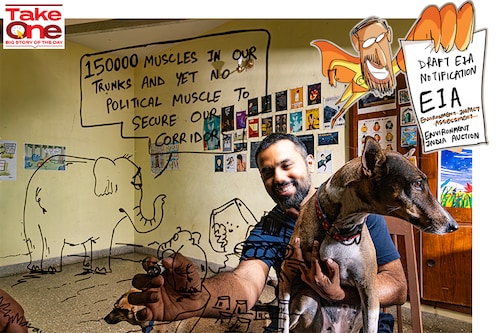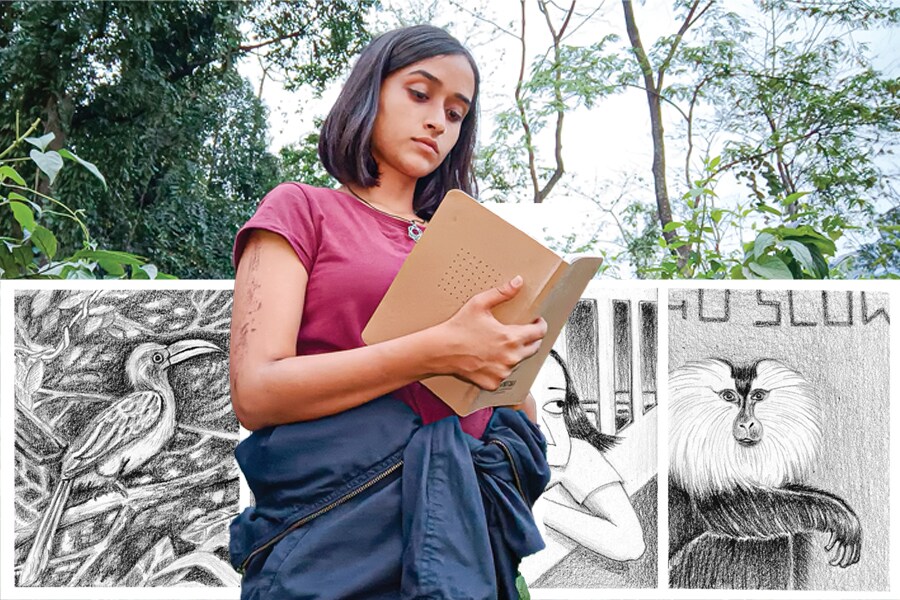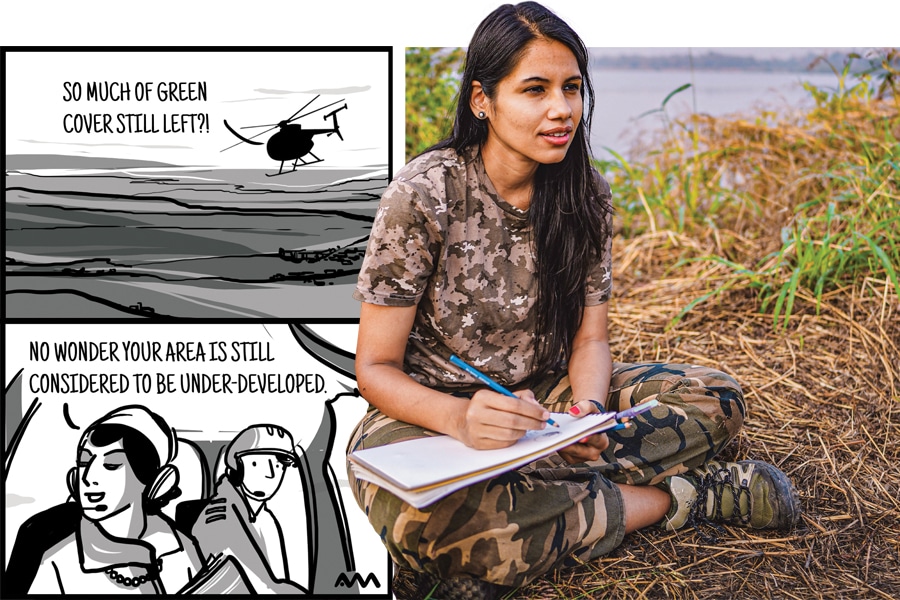Can graphic novels and cartoons raise awareness about climate change? These arti
With cartoons and graphic novels, a bunch of artists is raising awareness about climate change and ways in which to address different issues


Around three years ago, when an environmental notification widely thought to be diluting India’s green laws was being tossed about, cartoonist Rohan Chakravarty brought out his character Clearance Man. With a few strokes of his ‘brush’, he depicted Clearance Man going about destroying all obstacles for corporates and industries, and providing clearance to projects.
Though lawyers and climate experts had been tweeting about the draft Environment Impact Assessment (EIA) Notification 2020 to create awareness, engagement was low. “Because the news around the draft EIA was not simple enough, nobody really bothered reading more about it or understanding what it means for citizens," says Chakravarty, who has for the last 13 years been publishing Green Humour, a series of cartoons, comics and illustrations on wildlife, nature conservation and sustainability. Chakravarty teamed up with two environmental lawyers who explained “the most salient features of the notification and then I depicted that as a comic strip". The comic strip brought in engagement and eventually became one of the online faces of the protest against the draft EIA.
Climate change is at the centre of global dialogue on issues ranging from emissions to energy sources, and from sustainable fashion to wildlife biodiversity, the words meaning many things to many people. And though there is a vast amount of data and research, discussions around them remain abstract, full of jargon and far removed from everyday lived realities. Step in individuals and organisations who are using visual communication in the form of cartoons and comic strips to simplify and get the message and urgency of climate change across in a succinct, engaging and impactful way.
 Nikhil Chaudhary’s comic, Pedestranged, depicts the apathy of civic bodies towards the plight of pedestrians. Image: Courtesy Nikhil Chaudhary: Neha Mungekar Comic Courtesy: Nikhil Chaudhary
Nikhil Chaudhary’s comic, Pedestranged, depicts the apathy of civic bodies towards the plight of pedestrians. Image: Courtesy Nikhil Chaudhary: Neha Mungekar Comic Courtesy: Nikhil Chaudhary
“Comics are a very fertile medium as they let you humanise some of the issues so that they become more accessible for citizens to engage with," says architect-urban planner and independent comics artist Nikhil Chaudhary who makes connections between urban issues, planning and climate change. His 2012 comic, Pedestranged, depicts the apathy of civic bodies towards the plight of pedestrians, the hurdles a majority of the population faces as they try to walk in the city, and the problems that arise out of planning cities for cars.
Cartoonist and graphic storyteller Poorva Goel too sees storytelling as her role in the larger movement. “Comics are a more engaging way of reporting the stories I want to," says the 26-year-old who has worked on graphic publications and collaborates with experts, researchers, and social and environmental movements and organisations. Her stories, whether it be highlighting the threats to the biodiversity of the Western Ghats or the Idu Mishmi people affected by a dam project in Dibang Valley in Arunachal Pradesh, are a way to “make visible the inequity behind development". Originally from Dehradun, where she has seen forests and rivers disappearing “in my own short lifetime", she is currently doing her Masters in Graphic Storytelling in Belgium, and also attended the United Nations Convention on Biodiversity (COP15) in Canada on a fellowship last year. “At the COP15, they used very obscure, complex language around climate policy, which is very inaccessible to the lay person. So I see my role as a communicator to simplify that and present it in a more palatable, digestible form."
 Poorva Goel: Cartoonist and graphic storyteller Poorva Goel feels comics are a more engaging way of reporting stories. Comic Courtesy: Poorva Goel
Poorva Goel: Cartoonist and graphic storyteller Poorva Goel feels comics are a more engaging way of reporting stories. Comic Courtesy: Poorva Goel
Cartoonist Chakravarty too was part of the last two climate change COPs, COP26 and COP27, both of which he drew live and which, he says, “exposed me to an entirely new side of climate change that I hadn’t explored in my own work before".
“Under graphic design there are a lot of things you can do, from brand design to publication design, but what I love about comic strips is how it just makes such a large subject so brief, like one or two lines and images and you still get the whole story," adds designer Ashvini Menon. For Menon, her design skills were just a way of earning a living until a design thinking course at the National Institute of Design made her realise that her work could create social impact. Though she went on to work at Microsoft, she wanted to see how design could impact sustainability and wildlife conservation.
 Ashvini Menon: Designer Ashvini Menon landed a comic strip, Ecotism, in The Hindu. Comic Courtesy: Ashvini Menon
Ashvini Menon: Designer Ashvini Menon landed a comic strip, Ecotism, in The Hindu. Comic Courtesy: Ashvini Menon
While at Microsoft she did a part-time course on sustainable development in India at IGNOU, quit and moved to Mumbai, reached out to NGOs who she later collaborated with on design projects and also landed a comic strip Ecotism in The Hindu. Though she has moved back to a full-time job at Salesforce, she continues to do a bi-monthly cartoon strip Overherd in Protected Area Update, a newsletter by environment action group Kalpavriksha in Pune.
One of the challenges of communicating about climate change is that it happens gradually, over a long period of time, and so it’s difficult to make the connections. Comics, says Chaudhary, who works as a Cities Advisor with Climate-KIC, a European Union-affiliated non-profit organisation, are a good medium to tackle this because they allow you to go back and forth. “I can deal with almost two or three parallel stories side by side, juxtaposing the before and after visuals, what was before, what is in the present and also what it could be in the future in terms of a very compressed visual timeline," says Chaudhary, who employed the technique in Saline Intrusions.
 Richie Lionell, founder of data storytelling firm Bezalel Data, recently turned abstract data on temperature anomalies into an animated emoji.
Richie Lionell, founder of data storytelling firm Bezalel Data, recently turned abstract data on temperature anomalies into an animated emoji.
Richie Lionell, founder of data storytelling firm Bezalel Data, also recently compressed a vast time frame into a short, animated emoji on abnormal temperatures, turning abstract data into something easily digestible and immediately relatable. In the short ‘story’ a smile turns into a frown as the temperature, mapped from a cooler blue in 1850 gradually rises turning red by 2022. “If you’re just going to stick to traditional report structures, it’s not going to reach the masses. Data comics simplifies the language… the moment you bring comics, it forces you to shift from a written tone to a more conversational tone," says Lionell, who holds data storytelling workshops and has worked with IndiaSpend and Azim Premji University, where he got interested in climate data.
 Comic Courtesy: CEEW
Comic Courtesy: CEEW
In an era of too much information, cutting through the clutter and the bombardment of messages is another challenge. As is the fact that climate change feels far removed from lived reality. “When you’re bombarded with multiple channels of information, you sort of develop a thick skin as it were, where you may or may not react to it, and we are all at this point in time in that situation," says Alina Sen, senior communications specialist and archivist at thinktank Council on Energy, Environment and Water (CEEW), which under strategic outreach employs various modes to communicate on sustainability and climate change, from comics (a cartoon series What On Earth!) and short films to music and poetry (see box). The communication uses humour, is informative, not preachy, and provides action points to individuals, ways they can make a change. Images of gloom and doom, she says, may make you sit up, “but if you’re not going to show me a pathway to repair, where I can reclaim agency and do something about it, it’s not a great place for people to be in".
There should be action points that go beyond the common perception of planting a tree and bring in other images of what sustainability means, like perhaps riding an EV or making the Metro the transport of choice, she says. If climate change feels far removed from people’s reality, providing local hooks and connecting the dots helps, for instance between landslides and cyclones, and flooding events and getting stuck in the Metro. “If I sort of expand the syntax and the set of occurrences and events and connect one of them to you and say ‘were you here, did this not happen, so that could just be climate change’, then people will sit up and take notice," says Sen.
Even as his cartoons have been used by various organisations to create awareness, when Chakravarty brought home the message of the draft EIA through his comic strip, there were, he says, “as we all know 600,000 signatures and put the government on the back foot, at least then. Of course, with the Forest (Conservation) Amendment Bill 2023 now a lot of that has been reversed". But it drove home the point, he adds, that comics and art have the power to communicate a crisis better, and draw in more people from various backgrounds rather than just people who have something to do with science.
Goel agrees. She recollects a comic book she did for an NGO based on a report they had come out with. “And they said their accountant had never read any of their reports. But now that it was available in the form of comics, she read it for the first time. That made me think about how comics can make things more accessible and more interesting or fun to read," she says.
Not all impacts may be immediately tangible but almost all strike a chord or help start a conversation. Menon recollects how a comic about the burying of a lake for construction brought in reactions from students and people who had personally experienced it. And when Chaudhary put up a video of his pedestrian comic titled I Pedestrian, “it went, as they say, viral", he says. He got messages from all over the world, including one from someone in South Korea who wrote in saying how they had showed the story to someone who had been in a life-threatening accident, “just to show that it’s not just your individual fault that you were in harm’s way, but a range of issues that contributed to you being in that position", a touching reminder of seeing the reach of his work in ways he didn’t really expect.
And if there is enough awareness and individual action, it ultimately adds up. “If there are enough individuals who are willing and wanting to change the way they live, the markets will follow suit because they will now cater to a growing demand," says Sen of CEEW, adding that then policy will fall in place. “It will have to change because you have your two big pillars, your people and your markets, responding to this new way of life, which is less of use and throw, but more of reuse, recycle, the circular economy. That’s the opportunity. We have to look at action and not apathy. I think that’s the responsibility that all of us have as communicators."
First Published: Aug 23, 2023, 13:15
Subscribe Now